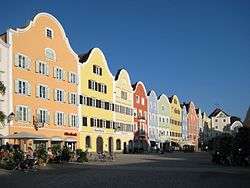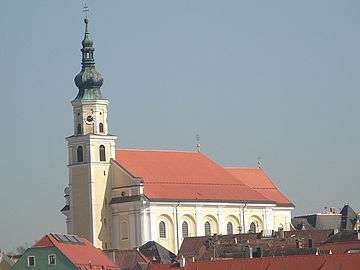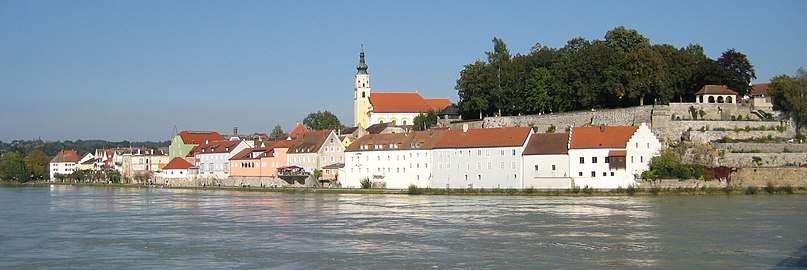Schärding
![]()
Schärding | |
|---|---|
 | |
 Coat of arms | |
 Schärding Location within Austria | |
| Coordinates: 48°27′25″N 13°25′54″E | |
| Country | Austria |
| State | Upper Austria |
| District | Schärding |
| Government | |
| • Mayor | Franz Xaver Angerer (ÖVP) |
| Area | |
| • Total | 4.08 km2 (1.58 sq mi) |
| Elevation | 313 m (1,027 ft) |
| Population (2018-01-01)[2] | |
| • Total | 5,253 |
| • Density | 1,300/km2 (3,300/sq mi) |
| Time zone | UTC+1 (CET) |
| • Summer (DST) | UTC+2 (CEST) |
| Postal code | 4780 |
| Area code | 07712 |
| Vehicle registration | SD |
| Website | www.schaerding.ooe.gv.at |
As of 1 January 2014, it had a population of 4,874.
History and features
The Bavarian family Wittelsbach owned the town until 1779. Eyewitness Travel Austria guide describes Schärding's best feature is its central square, the north end of which sits the Silberzeile row of gabled-roof houses. Other features include the large Church of St. George. The castle is gone but in its gateway there is a local museum with religious sculptures and those by Johann Peter Schwanthaler.[3]
Geography
The town sits at an altitude of 313 meters in height in Innviertel. It measures 4.1 kilometers from north to south, 1.9 km from west to east. The total area is 4.08 km². 2.4 percent of the area is forested, 31.7 percent are used for agriculture.
The Inn River forms the border with the neighboring German state of Bavaria. Directly opposite the town on the Bavarian side of the river is Neuhaus am Inn, which is accessible via two bridges.
History
The area around the current town has been inhabited since the Neolithic period. In 15 B.C., the Romans were advancing to the Danube and the Innviertel and Schärding a part of the Roman province of Noricum was populated by Celts in the area. Around 488, King Odoacer withdrew its troops to the south. West Germanic Bavarians migrated about 30 years later up the Danube and occupied the area between the Vienna Woods and Lech. Place names ending in -ing, -ham and -heim clearly indicate the change of hands. The name of the district capital Scardinga came from the name given to the settlement by a man named Skardo and his family.
As Passau farmyard scardinga Schärding was first mentioned in records in 806 as a Passau farmyard. It has been the town center of the county of the Counts of Formbach-Neuburg since the 10th century. The castle rock in the immediate vicinity of the Inn River was utilized early as a favorable geographical location to plant an attachment. From 1160 it was ruled by the Counts of Andechs, from 1248 the Wittelsbach dynasty.
Benefiting from its location by the Inn Schärding became a center of trade, particularly for salt, timber, ores, wine, silk, glass, grain, textiles and livestock.the town was granted market rights at the end of the 13th century. After many changes of ownership in the 14th century, for example on 20 January 1316 (to the Wittelsbach), on September 24, 1364 it went to Rudolf IV of the House of Habsburg. 1369 ended the peace of Schärding the dispute between Austria and Bavaria to the Tyrol, which fell to the Habsburgs who pawned the town back to Bavaria.
From 1429 to 1436 the fortifications of the city were built by Duke Ludwig the Gebarteten. Among others, the outer castle gate, the moat, Linz and Passau Gate and the Water Gate were built during this time. During the Thirty Years' War, especially in the years 1628, 1634, 1645, 1647 and 1651, the plague raged in the city.
During the War of the Austrian Succession, a Bavarian army was defeated near the town on 17 January, 1742, during a winter offensive led by the Austrian Field Marshall von Khevenhüller.
In April 1939, when Mayor Hans Ominger, Kreisamtsleiter Johann Pachman and other National Socialists hosted a hunters' meeting at the Aschenbrenner Inn, a portrait of Hermann Göring was decorated with fresh greens. The men celebrated the incorporation of the neighboring German-inhabited Sudetenland of Czechoslovakia into German hunting grounds.[4]
Population
Municipal structure
The municipality comprises the following five localities (in parentheses population status as of October 31, 2011).
- Allerheiligen (870)
- Brunnwies (199)
- Kreuzberg (236)
- Inner city Schärding (567)
- Schärding suburbs (3004)
Population
|
|
|
Religion
The residents are predominantly Roman Catholic, at 83.5 percent of the entire town population. The second largest religious community is Muslim with 5.0 percent of the population. Lutherans make up 2.8 percent, whereas; 5.6 percent have no religious affiliation.
In popular culture
The asteroid 178243 Schaerding was named in its honour by its discoverer, Richard Gierlinger, who calls Schärding his hometown.
Notable people
- Ingrid Nargang (1929–2019), judge and contemporary historian
Gallery
 Saint George's church
Saint George's church Schärding at the Inn River
Schärding at the Inn River
References
- "Dauersiedlungsraum der Gemeinden Politischen Bezirke und Bundesländer - Gebietsstand 1.1.2018". Statistics Austria. Retrieved 10 March 2019.
- "Einwohnerzahl 1.1.2018 nach Gemeinden mit Status, Gebietsstand 1.1.2018". Statistics Austria. Retrieved 9 March 2019.
- "Upper Austria: Schärding," Eyewitness Travel Austria (New York, New York: Dorling Kindersley Ltd., 2012), p. 197.
- Anna Rosmus Hitlers Nibelungen, Samples Grafenau 2015, pp. 205f
| Wikimedia Commons has media related to Schärding. |